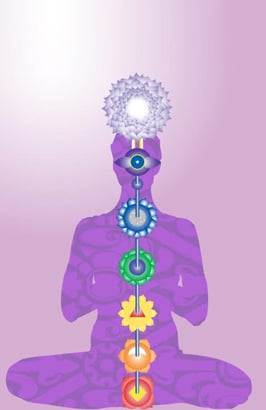What Is The Meaning of Anahata Chakra?
 The anahata chakra is the fourth chakra. The anahata chakra expresses as love, for either the divine or the material world. (1) The literal meaning of anahat is unbeaten, untainted, or unhurt, which indicates purity, cleanliness. That is why Jesus said, “Blessed are the pure in heart for they shall see God.”
The anahata chakra is the fourth chakra. The anahata chakra expresses as love, for either the divine or the material world. (1) The literal meaning of anahat is unbeaten, untainted, or unhurt, which indicates purity, cleanliness. That is why Jesus said, “Blessed are the pure in heart for they shall see God.”
Function of the Chakra
Commonly called the heart center, the anahata chakra is located in the dorsal region of the spine near the physical heart in the center of the chest. The chakra is also known as the dorsal center. The nerves of the anahata chakra radiate out to the heart, lungs, and chest, and into the arms and hands.
The anahata chakra is one of the seven chakras that store and distribute energy; the chakras also serve as the repositories of psychological or mental tendencies, habits, and desires, which descend from the subconscious mind. (2)
The energy that emanates from the anahata chakra is freeing and expansive. When one’s energy is going downward toward lower consciousness, the chakra is expressed as connections to particularized matter in the form of likes and dislikes; it may lead one toward further involvement in the world of delusion. When the energy is moving in a positive direction, the heart chakra can express itself as the unconditional love, which leads one toward spiritual liberation. (1)
Reference to the anahat chakra indicates the “feeling” (Chitta) quality of the heart. When the heart’s feelings move inward and upward (towards experiencing God), it becomes “Devotion”. And when that same energy flows down and outward into the world it becomes “Emotion.” Emotions keep one bound to this delusive world (Maya). Due to the dualistic nature of Maya (Dwait), heart qualities keep us bound to the feelings like love-hate, peace-unrest, pleasure- pain, happiness-sorrow, and so on.
Qualities of the Chakra
The anahata chakra corresponds to the element of air. If the energy of the chakra is directed toward the lower elements, then one tends to feel a specific affinity for this or that object. But at the anahata chakra, one ultimately neutralizes likes and dislikes by transmuting the energy into divine love at its source. (1)
The distinction between divine love directed toward the entire universe and particular objects, however, is extremely fine. The particularized love may be characterized as “emotion,” whereas the expansive love may be better characterized as “devotion”.
If one directs pure and selfless love toward desired objects, he may be led once more into material delusion. If instead one directs the sense of divine kinship toward the fifth or bishuddha chakra and the element of ether, one may experience an impersonal and expansive oneness with all life. While impersonal love may seem cold or aloof, it allows one to both experience God fully in oneself and to recognize that God reflected in other beings. (1)
One must develop the heart chakra after working with the lower chakras. Since the air element cannot be suppressed but rather stabilized, freed from prejudices, fired with enthusiasm, and redirected toward the divine, one who does not develop the lower chakras may experience non-attachment as apathy. The expansive and liberating quality of the anahata chakra may not be feigned; for example, the person who chooses not to be loyal to anything may not advance on the spiritual path unless he devotes himself to his particular path. (1) Spiritually-minded persons, especially those of devotional nature, tend to experience their consciousness centered in the heart chakra. (3)
The anahata chakra also corresponds to the color green, traditionally. However, Paramhansa Yogananda said that its real color is blue. (4) Energy flows from it in twelve rays. (5) It produces a sound like a deep bell. (6) The character Bhima symbolizes the anahata chakra in the Bhagavad Gita. (7)
When Anahat Chakra Opens
One scriptural aphorism in Indian philosophy is “Yogas Chitta Vritti Nirodh,” which says: When the whirlpools of feelings are neutralized, union with God (Yoga) takes place!
Yogis say that there is a magnetic field in between anahat chakra and ajna chakra (the spiritual eye). When anahat is awakened, a short circuit which magnetically attracts the highest spiritual perceptions. While describing his “Samadhi” experience, Paramhansa Yogananda says in his book Autobiography of A Yogi, “I cognized the center of the empyrean as a point of intuitive perception in my heart.” Here the heart is not about the physical organ but the anahat chakra, which is just behind the physical organ.
The heart quality can be developed by chanting, japa, kirtan etc., in addition to meditation practices. Upon opening this chakra, the heart’s love flows out to encompass all humanity and does not remain limited to a particular group of people.
- a b c d e Chakras for Starters, by Savitri Simpson. Chapter 5, “The Air Element.”
- ↩ Chakras for Starters, by Savitri Simpson. Chapter 1, “The Seven Gates to Freedom.”
- ↩ The Essence of the Bhagavad Gita, explained by Paramhansa Yogananda. Chapter 12, “The Nature of Right Action.”
- ↩ Essence of the Bhagavad Gita, explained by Paramhansa Yogananda. Chapter 21, “Final Liberation.”
- ↩ Essence of the Bhagavad Gita, explained by Paramhansa Yogananda. Chapter 18, “The True Yoga.”
- ↩ Essence of the Bhagavad Gita, explained by Paramhansa Yogananda. Chapter 9, “Sanjaya Speaks.”
- ↩ Essence of the Bhagavad Gita, explained by Paramhansa Yogananda. Chapter 5, “The Genesis of the Story.”
